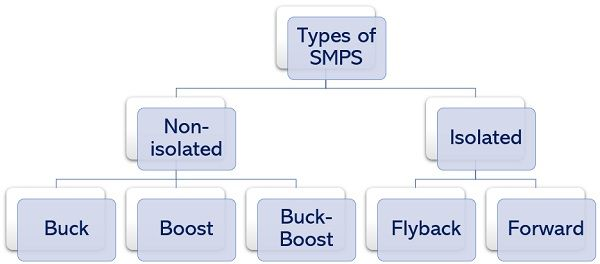What is a switching power supply?
An industrial power supply is mainly used in different difficult environments that require long-term, large power supply. In various industrial or industrial automation production processes, the power supply is the most basic production component that requires high stability and safety protection. Therefore, the requirements for the quality and stability of the product itself are naturally different from the power supply of general computers or other equipment. This also makes the price of industrial power supply much higher than that of general power supply, but it is still accepted and used by the market.
However, switching power supply is becoming more common and, in most cases, replaces the traditional theoretical linear AC-DC power supply due to reduced power consumption, reduced heat dissipation, and reduced size and weight. Switching power supplies are now available in most devices and switched-mode power supplies are becoming more mature, so almost anything that requires a highly efficient power supply is using switching power supply.
What is a Switching Power Supply?
Switching Power Supply, also known as Switch Mode Power Supply (SMPS), is a high-frequency power conversion device and a type of power supply. Its function is to convert a bit-perfect voltage into the voltage or current required at the user’s end using a different architecture. The input to a switching power supply is usually either AC power (e.g. mains) or DC power, and the output is usually a device that requires DC power, such as a personal computer, and the switching power supply converts the voltage and current between the two.
Check out the following for the differences between switching power supply and linear power supply:
Switching Power Supply
Efficiency: high
Stability: medium
Hold time: about 16ms
Circuit design: complex
Weight and volume: small and light
Efficiency: low
Stability: high
Hold time: about 1ms
Circuit Design: simple
Weight and volume: large and heavy
What is a Switching Power Supply Working Principle?

A switching power supply is a device that efficiently converts electrical power from one form to another. Its working principle involves several key steps:
Firstly, the AC power from the mains is rectified, converting it into high-voltage DC using a bridge rectifier.
Next, the rectified DC undergoes filtering to smooth out any AC ripple. This is achieved by using capacitors, resulting in a relatively stable high-voltage DC.
The heart of the switching power supply is its switching circuit. This circuit typically consists of a switch, often a transistor, and a control circuit. The switch rapidly turns on and off at a high frequency, usually ranging from tens of kHz to several MHz.
During the switch-on period, current flows through the switch, storing energy in an inductor. When the switch turns off, the inductor releases the stored energy into a capacitor or load.
This switching action allows the switching power supply to regulate the output voltage efficiently. By controlling the duty cycle of the switch (the ratio of on-time to off-time), the average output voltage can be adjusted as needed.
Overall, the switching power supply efficiently converts electrical power by rapidly switching between different states, enabling stable and regulated output voltages.
Where is a Switching Power Supply Used?
Switching power supply is used in a wide range of applications due to its efficiency, compact size, and versatility. Roughly speaking, it can be divided into 10 major groups:
1. Consumer Electronics: Found in TVs, computers, smartphones, and audio equipment.
2. Telecommunications: Used in routers, modems, switches, and base stations.
3. Industrial Equipment: Powers machinery, automation systems, and control systems.
4. Power Supplies: Used as adapters and chargers for devices.
5. LED Lighting: Powers LED lighting systems.
6. Medical Devices: Powers patient monitors, ultrasound machines, and diagnostic devices.
7. Automotive Electronics: Used in vehicle electronics.
8. Renewable Energy: Used in solar and wind power inverters.
9. Aerospace and Defense: Used in avionics and military equipment.
10. Data Centers: Powers servers, networking equipment, and storage systems.
Advantages and Disadvantages of Switching Power Supply
Given below the Advantages and Disadvantages of SMPS
Advantages:
(1) High Efficiency: More efficient than linear power supplies, reducing power consumption and heat dissipation.
(2) Compact and Lightweight: Smaller and lighter due to higher efficiency and smaller components.
(3) Wide Input Range: Can operate with a wider range of input voltages.
(4) Stable Output: Maintains a stable output voltage despite input or load variations.
(5) Higher Power Output: Can deliver more power in a smaller size.
(6) Lower Heat Generation: Produce less heat.
Disadvantages:
(1) Complexity: Circuits are more complex.
(2) EMI: Can generate electromagnetic interference.
(3) Voltage Ripple: Output may have a higher ripple.
(4) Noise: Can introduce audible or high-frequency noise.
(5) Design Sensitivity: Sensitive to component variations.
(6) Cost: Initial costs can be higher.
What is the Type of Switching Power Supply?

First, the switching power supply can be broadly categorized into two categories –
1. Non-isolated SMPS
2. Isolated SMPS
In Non–isolated SMPS the input and output share the same ground or it can be said that there is an electrical connection between the input and output. But in isolated SMPS the input and output are isolated from each other by a transformer which gives safety from any electric shock by the input power supply (AC).
In Non-isolated SMPS, the basic topologies of SMPS can be categorized based on Input-Output Voltage as follows –
1. Buck Converter:
• Steps down the input voltage to a lower output voltage.
• Offers high efficiency.
• Commonly used in voltage regulation for processors, graphic cards, and battery charging.
2. Boost Converter:
• Steps up the input voltage to a higher output voltage.
• Useful for powering devices requiring higher voltages than the input source.
• Found in LED drivers, photovoltaic inverters, and automotive electronics.
• Can step up or step down the input voltage to maintain a regulated output.
• Provides flexibility in powering devices with varying input voltages.
• Used in battery-powered devices, portable electronics, and automotive systems.
However, in isolated SMPS, the basic topologies of SMPS can be categorized based on a transformer as follows –
• Uses a transformer for isolation.
• Suitable for low to medium-power applications.
• Commonly found in low-power adapters, battery chargers, and LED drivers.
• Also employs a transformer for isolation.
• Energy is transferred to the output continuously during the switch-on period.
• Offers higher efficiency and power handling capabilities compared to flyback converters.
• Used in medium to high-power applications such as DC-DC converters and industrial power supplies.
Development Trend and Current Situation of Switching Power Supply
Development Trends:
The development of switching power supply is focused on increasing efficiency through advanced semiconductor materials like gallium nitride (GaN) and silicon carbide (SiC), which allow higher switching frequencies and reduce power losses. Miniaturization is another key trend, with improved circuit design and component integration leading to smaller, lighter power supplies. Digital control integration enables precise regulation and advanced features such as power factor correction (PFC). Switching power supply is also being optimized for renewable energy sources, handling variable input voltages and incorporating energy storage solutions. Enhancements in cooling, materials, and protective features are boosting reliability and durability, especially in demanding environments. Additionally, the integration of IoT technologies allows for remote monitoring, diagnostics, and control, contributing to smart grids and advanced energy management systems.
Current Situation:
Switching power supplies are widely used in consumer electronics, industrial automation, and renewable energy systems due to their high efficiency, compact size, and reduced heat generation. Technological advancements have made SMPS more reliable and cost-effective, leading to their dominance over traditional linear power supplies.
FAQs on Switching Power Supply
Q1: What are the main components of an SMPS?
A1: The main components of an SMPS include a rectifier (to convert AC to DC), capacitors (for filtering), a switching circuit (usually consisting of a transistor and control circuit), an inductor (for energy storage), and feedback/control circuits (to regulate the output voltage).
Q2: Are SMPS safe to use?
A2: Yes, SMPS are safe to use when designed and manufactured properly. They adhere to safety standards and regulations to ensure protection against electrical hazards.
Q3: Can SMPS generate electromagnetic interference (EMI)?
A3: Yes, the high-frequency switching operation of SMPS can generate electromagnetic interference (EMI). However, proper design and shielding can minimize EMI.
Q4: How are AC and DC converted by SMPS?
A4: Generally speaking, an SMPS uses an input filter and a rectifier to first convert the AC power supply voltage into a DC voltage. After that, a chopper “chops up” the DC voltage so that the transformer's primary winding’s input can produce a voltage made up of several square-wave high-frequency pulses (20 kHz–10 MHz).
Q5: How do I choose the right SMPS for my application?
A5: When choosing an SMPS, consider factors such as input voltage range, output voltage/current requirements, efficiency, size, reliability, and safety certifications. It's also important to ensure compatibility with your specific application requirements.


